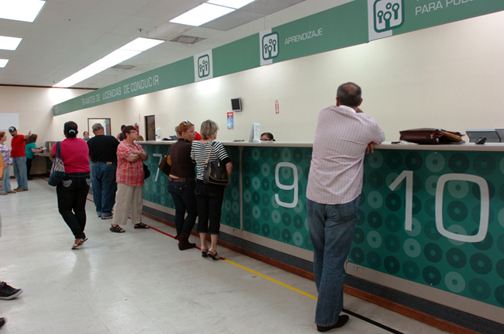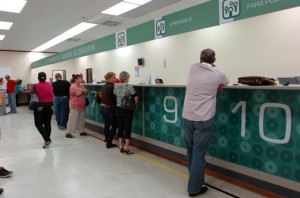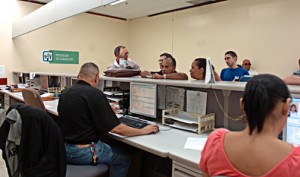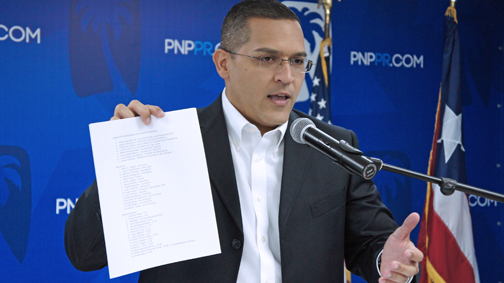DTOP driving technology to curb motor vehicles office hassles


The typically long lines at the motor vehicles offices could be considerably shorter if people went online to complete certain procedures, an agency official said. (Credit: DTOP)
It’s no secret that getting, renewing or replacing a driver’s license — or just getting a plain ID card — in Puerto Rico is about as unpleasant as getting a flat tire when you don’t have a spare. The complicated forms, the long lines, and the sometimes irritable staff, can all add up to an all-day, cumbersome process that thankfully usually comes around every four or five years.
Part of the decades-old problem for Puerto Rico drivers has to do with the fact that citizens and some agency staff have not adopted technology at its fullest, despite its availability, said Moisés Deida, executive director of the Department of Transportation’s (DTOP) Drivers Services Division.
“The great majority of services that people go to get at the motor vehicle centers can be obtained online,” Deida said. “We’ve been trying to drive the message through our website and through the media about just how much can be done online.”
Some of those services include downloading forms, paying off tickets, paying for vehicle tags for cars less than two years old, and renewing driver’s licenses. However, to be able to complete the latter transaction, there is a catch: renewing a driver’s license online requires having the new barcoded digital card.
“There is still a large number of people who don’t have that new license, but we’re working on converting them,” Deida said, admitting that 30 percent of the 2.9 million people who have valid Puerto Rico driver’s licenses still carry the older ID, so they have no choice but to stand in line. Putting the new ID in their hands could take another two years, he said.
In the meantime, those people do have the option of going through the agency’s website to use another seemingly little-known service that since late 2010 has given drivers the ability to set up appointments.
“We established the online appointment system so that people can choose the day, the time and the transaction they need to get done, so all they have to do is show up at the agency and somebody will be there waiting for them,” Deida said.
But the fact remains that computer usage in Puerto Rico is still low, so online transactions are still minimal.
Investing in upgrades
Acknowledging that completing the process in person can take hours and test anybody’s patience, Deida said the DTOP’s Drivers Services Division plans to invest nearly $4 million through year’s end to improve computer systems and people flow.

The agency will be investing in technology to prevent system crashes, Moisés Deida said. (Credit: DTOP)
The investment is split between $2 million and $3 million to expand broadband capacity and establish redundancy mechanisms to eliminate notorious system crashes that bring procedures to a screeching halt.
“Basically, we would be resolving the problem of system crashes that really create a crisis at our offices and for our citizens,” he said.
On the other hand, the agency will be spending another $900,000 to install a monitor system at each of the 15 motor vehicles offices islandwide to assign turns and establish order, he said.
“We want to visually provide orientation to the public, much like banks do with their take-a-number systems,” Deida said, confirming that doing this should eliminate employee need to shout out people’s names when their turn is up or their license is ready.
Stamps, headshots and health certificates
Several other seemingly archaic steps associated with going to the motor vehicle offices are paying for the required “sellos,” or stamps, getting a health certificate signed off by a doctor, and providing two-by-two headshots.
“These are all things that we’re working on eliminating, but some require amending existing laws,” he said, mentioning the document that a doctor must certify confirming a driver’s clean bill of health as one such example.
“I don’t believe it’s necessary and we all know there isn’t a doctor out there who will not sign off on that certificate for a driver’s license,” he said. “But we’re required by law to ask for one, and drivers who renew online can get a doctor to email the form to us. However, we’re working on a bill to eliminate that and replace it with an sworn statement.”
Then there are the headshots. Deida said the agency stopped requiring that citizens provide the two photos more than a year ago, but his statement contrasts the contents of some of the DTOP’s online forms, which still instruct people to attach their pictures to the application.
As for buying the stamps, whose amount depend on the service required, Deida said they too can be paid online through the Treasury Department’s virtual collections agency, printed out, and turned over to DTOP.
“It’s our goal that in the near future, everything is done online,” Deida concluded.









